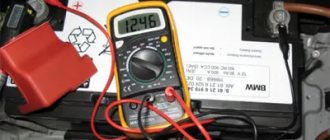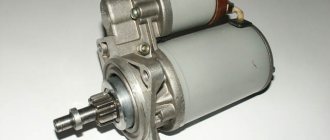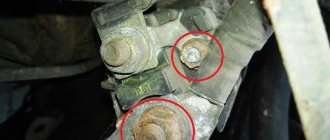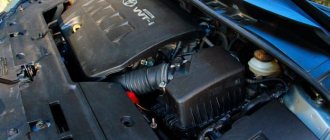Which engine is better: gasoline or diesel? An experienced motor mechanic answers
Hello dear subscribers and readers of my channel!
Today there will be a topic, the discussion of which has already turned into a real war of opinions. Namely, which engine is better? Petrol or diesel? As a car enthusiast, I will be incompetent in this matter, since I have never driven diesel cars (except for trucks, of course).
Therefore, in resolving this dispute, I decided to involve an experienced motor mechanic, who over the course of his entire work experience has gone through so many engines that he has long decided for himself which engine is better and which is worse.
But it would not be fair if praising one engine and humiliating another began now. Of course this won't happen.
I asked the mechanic to answer a few questions and compare the engines according to several criteria in order to collect all the pros and cons of these “warring parties” (two engines), and you could finally decide for yourself - a car with which engine would be better for you. you.
Operating principle of engines
Whether gasoline or diesel, they are both internal combustion engines.
In a gasoline engine, the device is such that the fuel assembly (fuel-air mixture) is formed in front of the cylinder, or more precisely in the intake manifold. At the end of the compression stroke, air and gasoline vapors are mixed.
This mixture is distributed evenly throughout the entire volume and, as a result of compression, the temperature rises to 500˚C, which is much lower than the ignition temperature of gasoline. This is where the spark plug comes to the rescue, giving a spark and helping to ignite the mixture.
A diesel engine is different in that the air is compressed in the cylinder itself, and not just compressed, but under a pressure of 30-50 bar. The result of this compression will be an increase in air temperature to 900˚C. At the same time, diesel fuel is sprayed from the injector before top dead center. When interacting with air and increasing temperature, fuel droplets evaporate and a fuel-air mixture is obtained, which subsequently self-ignites and burns.
Diesel engine. Similarities and differences
This type of engine is also an internal combustion engine, but it has distinctive features that make it possible to sharply separate engines operating on the principle invented by Rudolf Diesel from other internal combustion engines operating on “light” fuels such as gasoline “in motoring” or kerosene “in aviation”.
Differences in the fuel used determine differences in design. The fact is that diesel fuel is relatively difficult to ignite and achieve instant combustion under normal conditions, so the method of ignition from a candle is not suitable for this fuel. A diesel engine ignites due to its contact with air heated to a very high temperature. For this purpose, the property of gases to heat up when compressed is used. Therefore, a piston running on a diesel internal combustion engine compresses air, not fuel. When the compression ratio reaches the maximum, and the piston itself reaches the highest point, an “electromagnetic pump” injector installed instead of a spark plug injects dispersed fuel. It reacts with hot oxygen and ignites. Next, work occurs that is also typical for a gasoline internal combustion engine.
In this case, the power of the internal combustion engine does not change by the proportion of the mixture of air and fuel, as in gasoline engines, but solely by the amount of injected diesel, while the amount of air is constant and does not change. At the same time, the operating principle of a modern gasoline unit equipped with a nozzle is absolutely not similar to the operating principle of a diesel internal combustion engine.
Electromechanical spray pumps operating with gasoline are designed primarily to more accurately measure the injected fuel and interact with the spark plugs. Where these two types of internal combustion engines are similar is in their increased demands on fuel quality.
Since the air pressure created by the operation of the piston of a diesel engine is much higher than the pressure exerted by the compressed air-gasoline mixture, such an engine is more demanding on the clearances between the piston and the cylinder walls. In addition, it is more difficult to start a diesel engine in winter, since diesel fuel thickens under the influence of low temperatures, and the nozzle cannot spray it well enough.
Both the modern gasoline engine and its diesel “relative” are extremely reluctant to run on DT gasoline of inadequate quality, and even its short-term use is fraught with serious problems with the fuel system.
Engine efficiency and power output
The efficiency (coefficient of performance) of a diesel engine is much higher than that of a gasoline engine. This is due to the most efficient combustion of the air-fuel mixture due to the increased compression ratio.
If a gasoline engine has a compression ratio of exactly 10 units, then for diesel engines this figure is twice as high! That is 20 units. On average, the efficiency of a diesel engine is 40% greater than that of a gasoline engine, and at the same time, diesel engines consume 20% less fuel.
But in terms of power, diesel cars are inferior to gasoline ones.
General recommendations
The reliability and service life of the engine depends on many factors, namely operating conditions, the quality of the engine oil and fuel mixture, air purification, and so on. At the same time, there is no recipe for the “immortality” of a motor. There are only recommendations that can significantly extend its life.
So, when operating the engine, follow these tips.
Oils
Fill only high-quality oil into the power unit, monitor its level and replace it in a timely manner.
Each manufacturer has its own recommendations, but on average, change the oil every 7-8 thousand kilometers, at most 10,000.
When choosing a lubricant, pay attention to its type and SAE viscosity index.
For example, a good option is synthetic or semi-synthetic oil 10W40.
Don't forget to pay attention to the purpose of the oil. If it can only be poured into a diesel engine, then the word “diesel” will appear on the label.
Fuel
Remember about the low quality of gasoline (diesel) at gas stations and change the fuel filter in a timely manner, do not forget about the adsorber.
From time to time, drain the accumulated sediment. If this is not done, then the entire fuel system will experience problems due to high hydraulic resistance.
The ideal option is to remove the fuel container at least twice a year and clean it thoroughly.
Timing belt
From time to time, inspect the condition of the timing belt and replace it in a timely manner, as if it breaks, it can bend the valves.
Even if the belt works “like a clock,” change it mercilessly after 60 thousand kilometers.
Otherwise, you risk your engine and even greater costs.
Spare parts
Buy only high-quality spare parts. Don’t skimp on your car and try to install only original parts.
Firstly, this increases the service life of the engine, and secondly, it frees you from additional costs in the future, because a low-quality unit can “pull” other parts with it or it itself will fail ahead of time.
Warming up the car
Try to warm up the car in winter (at least 1-2 minutes). As soon as the sound of the engine becomes more or less smooth, you can hit the road.
We strongly recommend installing an antifreeze heater on your car.
In addition, do not allow the speed to increase above four thousand. Such a load negatively affects the engine and reduces its service life.
How to ride
Avoid puddles if possible, or drive through them at minimum speed. If you “fly” into the water, there is a high risk of water hammer.
And for the chassis, this style of driving will be very harmful, because you don’t know how deep this puddle is, so there is a high probability of being left without wheels at all.
be careful
Show maximum attention to the engine. Always check the oil and coolant levels before starting the engine. However, never add cold coolant to a hot system.
Please note that the temperature difference should be no more than 15 degrees Celsius. Pay special attention to the tightness of all systems.
We will separately highlight recommendations for an injection engine.
Engine Operation
In theory, a diesel engine is more durable than a gasoline engine. This is due to a more durable cylinder block, crankshaft, pistons, and cylinder head. Since during development there is an emphasis on a high compression ratio.
But this is all in theory. In practice, a lot depends on the quality of the fuel. Diesel engines are the most demanding in terms of quality.
Unlike gasoline, diesel is divided into summer and winter grades. With summer fuel at a temperature of -15˚C, the fuel begins to thicken and the car simply will not start. Diesel engines also take longer to warm up; you will only be able to feel the warmth in the cabin after about 10 minutes. Therefore, if you live in places where severe frosts prevail, then you are better off choosing gasoline cars.
But diesel engines are not afraid of water, since they only use electricity to start.
Internal combustion engine structure
Engine design diagram.
The first piston internal combustion engines had only one cylinder of small diameter. Subsequently, to increase power, the cylinder diameter was first increased, and then their number. Gradually, internal combustion engines took on the form we are familiar with. The “heart” of a modern car can have up to 12 cylinders.
The simplest is the engine with an in-line cylinder arrangement. However, as the number of cylinders increases, the linear size of the engine also increases. Therefore, a more compact arrangement option appeared - V-shaped. With this option, the cylinders are located at an angle to each other (within 180 degrees). Typically used for 6 cylinder engines and larger.
One of the main parts of the engine is the cylinder (6), which contains a piston (7) connected through a connecting rod (9) to the crankshaft (12). The straight up and down movement of the piston in the cylinder is converted by the connecting rod and crank into rotational movement of the crankshaft.
A flywheel (10) is attached to the end of the shaft, the purpose of which is to ensure uniform rotation of the shaft during engine operation. The top of the cylinder is tightly closed by the cylinder head (cylinder head), in which there are inlet (5) and outlet (4) valves that close the corresponding channels.
The valves open under the action of the camshaft cams (14) through transmission mechanisms (15). The camshaft is driven by gears (13) from the crankshaft.
To reduce losses due to overcoming friction, removing heat, preventing scuffing and rapid wear, rubbing parts are lubricated with oil. In order to create normal thermal conditions in the cylinders, the engine must be cooled.
But the main task is to make the piston work, because it is the main driving force. To do this, the cylinders must be supplied with a combustible mixture in a certain proportion (for gasoline engines) or measured portions of fuel at a strictly defined moment under high pressure (for diesel engines). The fuel ignites in the combustion chamber, throwing the piston down with great force, thereby setting it in motion.
Engine Maintenance
In terms of service, not everything is so simple. Owners of diesel cars, due to the design features, must change oils and filters more often. In addition, you need to monitor the compression in the cylinders more often. In the event of a breakdown, repairing a diesel engine will be more expensive than a gasoline engine.
But it all pays off if you buy a car not for a year, but for at least 5 years and use it constantly. Due to low fuel consumption, you will save more than you spend on maintenance.
Diesel power unit - the second type of internal combustion engine
Another important type of engine, which has become an excellent alternative to a gasoline unit in everyday and commercial use, is the diesel power unit. Its standard advantages are considered to be less active fuel consumption and very noticeable traction. Such benefits make it possible to completely reformat your travel style and change your driving habits.
The diesel power unit also supplies fuel through injectors with significant atomization. This requires high purity of diesel fuel and significant safety of the fuel supply system, since the liquid is supplied to the injectors at a sufficiently high pressure. The operating principle of the unit is somewhat different from the gasoline one:
- fuel is supplied to atomization at a much higher pressure, it warms up even before entering the combustion chambers;
- under the influence of significant piston pressure in the combustion chambers, the fuel spontaneously ignites;
- the energy created in this case pushes the piston to the lower position, while pushing the other pistons up;
- the engine requires less fuel to operate, but the air supply is of great importance;
- for this reason, diesel engines almost always have a turbine; only turbodiesels are common;
- the unit creates very enviable piston power, so even at low speeds it has great traction.
Certain specifics of the operation of a diesel engine also cause some peculiarities of its operation. In particular, the driver will have to learn to change gears earlier, be content with low revs and control the car's traction. Modern turbodiesels consume 15-20 percent less fuel for the same power than gasoline units.
Large-capacity and high-torque diesel engines in industry can operate not only on petroleum products. Many units are even adapted to burn crude oil, and also use natural bio-oils as fuel, which ignite under high pressure. This could be one of the future perspectives of the automotive industry.











